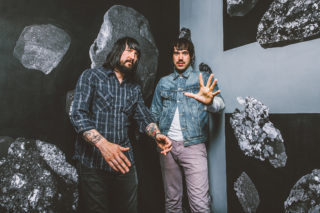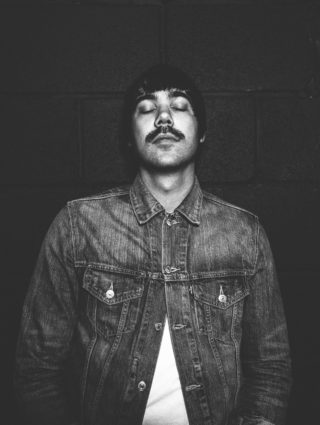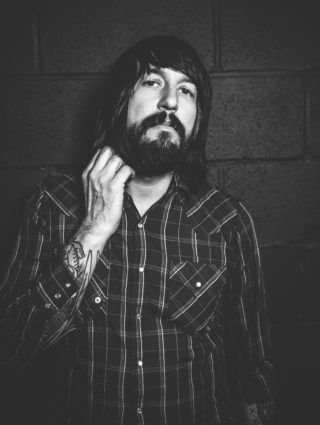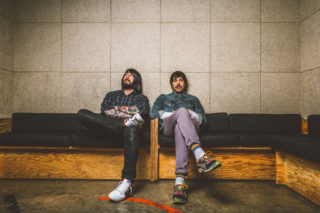Death From Above 1979’s modern day rock story of knowing when to quit
... and when to have another go

... and when to have another go
In 2006, a post on DeathFromAbove1979.com confirmed what most had already assumed: Jesse F. Keeler and Sebastien Grainger had gone their separate ways. But it wasn’t the result of a live-show implosion, media manipulation, or even a reaction to a failed album; just the harsh, honest admittance that things, and people, change.
“I know it’s been forever since I wrote anything on here…” Keeler posted. “I’m sure by now most of you assume the band isn’t happening anymore since there are no shows, no work on a new album, etc. Well I wanted to let you know that your assumptions are correct. We decided to stop doing the band… actually we decided that almost a year ago. We started as a punk band with pop aspirations and we met every goal we set for ourselves. A few weeks ago, the album finally went gold in Canada and that was the final mark I really wanted to reach. Over the last 3 years of touring, Sebastien and I had grown apart to such an extent that the only real time we spoke was just before we would play and during interviews. We both changed so much that the people we were by the end of it probably wouldn’t have been friends if they were to meet for the first time again. It’s a totally normal function of growing up.”
Put against the unyielding primal intensity of their music – a brutal overload of pounding drums, filthy bass, and bruising bravado – it was a double disappointment. That announcement should have been wracked with all of the anger, self-destruction and adrenaline-purging momentum that made their 2004 debut, ‘You’re a Woman, I’m a Machine’, such a glorious emotional wreckage of an LP. It was a break-up album for boys; a blazing, raging cyclone of twisted love, carnal lust and angry confusion that worked its sweaty, sleazy magic on indie disco floors, drove workout playlists, and gave those University dorm room Dawson’s Creek moments a barracking kick in the bollocks.
But as a statement, it was so grown up; so cynically balanced; so unresolved. It denied the drama, defiance, and emotion that coursed through ‘You’re a Woman…’s blazing 35 minutes, not so much slamming the door on Death from Above 1979’s short life span, more pulling it closed uncharacteristically gently. There’d be no breathless second album and no more riotous, limb-flailing live shows, just the resignation of what could have been. But where the truth of the split inevitably hurt, it was the hope that killed.

Keeler and Al-P joined forces to make MSTRKRFT an essential crossover success whilst Grainger went on to release his debut solo album, ‘Sebastien Grainger & The Mountains’, and go after the normal band dynamic he craved. Meanwhile, the Death from Above legacy continued untouched and undiminished. Five years on it was re-ignited as the band posted a new message on their site with Granger writing:
“So here we go. Jesse and I have been writing new songs and the only way we feel like we can make them any good is to go out and play them for people. We’re going to throw our little muscle bound babies to the lions and see who survives. We tried just jumping into the studio, but the songs lacked spirit. They lacked life. So this tour is song CPR. There’s no way for us to do it anonymously anymore, so we’re inviting you to come along with us. Watch us Do It. The way we used to. The way everyone used to. We’re a band, and bands just work it out together.”
It wasn’t quite the Death from Above elephant-face bat-signal burning into the Toronto night sky, but in a career that’s largely been reduced and then resurrected by these two book-ended messages, speaking with Keeler and Grainger, it’s apparent that this isn’t about a grand resurrection or reanimating Death From Above 1979 2.0 to them; it’s about adding to the legacy they created, and doing it the justice it deserves.
“It felt like we had discussed doing the band again, separately, but never together,” Grainger tells me at East London’s Ace Hotel, Shoreditch. “For a long time there was no reason, and it was never an option or something that came up but then all of a sudden it was ‘maybe’ and the timing was, strangely, very symmetrical. We talked together in 2010, which was ten years after we met for the first time, then we started playing in 2011, which was ten years after we started the band. It seemed right.”
“I don’t think either Sebastien or I thought at all about doing the band until he reached out,” says Keeler. “I’d never bumped into him once in all those years. I read his email and I wasn’t against the idea, which showed how my attitude to the band had changed. I’m not sure what inspired him to contact me but it felt like, for the first time, I was ok with trying to do it.”


After admittedly growing apart, and effectively ending the friendship with the split of the band, it’s heartening to see that the dynamic is a relaxed, easy, and visibly happy one. Despite the rigours of jetlag and the impending press grind, both Grainger and Keeler are thoughtful and forthright. Nothing seems off-limits as both speak honestly and openly about the past. It’s a refreshing approach, and I guess if there was never any genuine bad blood first time, then there’s been nothing left to fester for the last decade.
“The band was very binary,” Grainger admits. “Once we stopped doing it, then that was t, and we lived on our separate sides of the city [Toronto] and did our own things. The basis of our relationship, and the band, was a creative one. It didn’t end because we didn’t have anything left to say, it was just that we didn’t have the time with heavy touring and the travelling schedule and other pretty boring stuff,” he laughs.
“Also, at that age [Grainger 25 and Keeler 27], there’s a lot of weird personality stuff that’s happening and you’re trying to establish who you are. Some people do that in school, or when they leave University or get a career but we were going through that quite intensely with someone else and a lot of other people. At that point, because we were making it up as we went along, there was no precedent for it, and it became, for me, like I couldn’t separate myself from everything, and as an artist this wasn’t all I had to say.
“I think that went for both of us,” Grainger continues. “We had more to say, musically, and if we couldn’t do it through the band, we’d go and do it somewhere else. Personally, I didn’t want to be that dude, whoever I fucking was. I was sick of the band, sick of myself, sick of the whole thing and just wanted to start from scratch. We went away and did our separate things but the band kept going without us, so when we came back to it, we were able to see it as this third thing, this objective point we could reference and appreciate from a different perspective. We also want to honour that because it’s important to a lot of people, and important to us.”
Flick back to the early-mid noughties and it’s difficult to not get doe-eyed about the bands that had an impact on music at that time: The Strokes, Interpol, TV on the Radio, Yeah Yeah Yeahs, The Walkmen, and The Black Keys were all on the rise, and the likes of Metric, The New Pornographers, Arcade Fire and DFA 1979 were all lovingly lumped in together as one big happy Canadian family. But where the majority of the above fell foul of difficult second/third releases, member changes or the general apathy that involves following a band you love through the inevitable lulls and changes of direction, the Death from Above legacy remained crystalised in one 35-minute salvo and two mutant elephant heads.
“The way I’d describe it is that it’s a bit like an architect who creates an apartment building, and it sits there, and the architect’s work is done once the building’s up,” Keeler ruminates, “but it’s pretty cool to stop by once in a while and see that it’s become a home, and it’s been fixed up, and it’s being used and lived in. Being in the band, I think it all comes back to a similar point: that the band has become something that goes beyond both of us. That it grew and created new fans in our absence is a pretty cool feeling.”
Grainger agrees. “I know how hard it is to get people excited about something and our band started and existed in a time when, I think, people had a different relationship to music, and media, and art, and that appreciation is a special thing that shouldn’t be taken for granted. I appreciate the fact we were able to create something that meant something to them, because that’s the goal – art is not entertainment,” he says. “I’ve done a lot of other stuff to varying degrees of success, and I’ve been satisfied with other types of music and projects in various different ways but there’s nothing quite like the experience I have playing in this band. There’s a real connection to the audience and the devotion that goes both ways, and that’s not something to take lightly because we’re very fortunate to have that. And fuck, man, a lot of people work their whole lives and don’t even come close to it and we’re lucky that all those years we worked at a suicidal rate paid off in that respect.
After getting back together in 2011, the reality of practice sessions and touring provided the perfect opportunity for Grainger and Keeler to find out if they could recapture the band’s original spirit. In many respects it was the acid test, not just for their personal dynamic but for everything from nailing the live show to potentially creating new songs, and pressuring themselves to live up to the standards they’d previously set.
“What we think of as the reunion tour was just us playing a couple of shows then playing a few more as more people got interested,” Keeler explains. “After we’d been everywhere once, we didn’t want to play over and over again without having new songs, so we started recording, ourselves, in a studio we had access to in Toronto, and decided it wasn’t right. We needed to go and tour like we did for the first album because those songs were formed and shaped on the road, and we wanted to get to that place again. We wanted to make sure if we were going to do another record, it wouldn’t cheapen anything.”
On the road, and firmly on the comeback trail, it didn’t take long for the dynamic between the two to click once again. But instead of settling into old roles too easily, the emphasis, this time, was on pushing old boundaries (and bodies) from the outset.
“We kind of got into our own roles, then at the same time broke free of them,” says Grainger. “We worked with a producer this time, so we were more critical of the music and what was best for the song, whereas before we strictly acted on instinct. Now that we’d set a precedent we had to ask ourselves: ‘is this right? Is this cool? Is this the band?’”
“I think at first we were also both curious to see if we were able to do what we did in the past,” Keeler smiles. “There were times when I’d try and imagine the song in my head and have no idea how to play it in the ten years since my hands had done anything like that. There were also times I’d just pick up the bass and start doing it, and watch my body play the song. It was a really strange thing because my hands were doing things faster than I could think to do it!”
The hard result is ‘The Physical World’; DFA 1979’s second album set for release next month. To them, it’s not the physical proof of their return, rather a direct continuation of their sound (albeit five years later); simply the band’s second album.
“I’ll speak for myself here, but there were things about the first record that I always wanted to change,” Keeler asserts. “Normally, you aim to get it next time round and this record corrects all kinds of things I wasn’t happy with on the first one. But it’s also created a whole new set of things that I want to outdo. It’s tough! Al-P said, ‘a record is never finished, only surrendered’, which is pretty pessimistic, but I feel like that’s the truth. Maybe I’m just always unsatisfied, but I like having an unreachable goal.”

Now a decade after their debut release, and now that they’re older and wiser, I ask them if they think the new album stays true to the original ‘punk band with pop aspirations aesthetic’ that outlined ‘You’re a Woman, I’m a Machine’ so defiantly.
“Yeah, I still see it that way,” Grainger agrees. “We came out of a hardcore scene in Toronto’s suburbs but I think it’s a very vague term where it’s not really a genre of music, more like an ethos. We didn’t really fit in hardcore but I think we were more punk, and I read something in the Everett True Nirvana biography where he defines hardcore as lifestyle and punk as fashion, and in that sense, I think it’s very much true. If punk is fashion we’re sometimes wearing those clothes, musically.”
“We were in punk bands and the hardcore scene at a very interesting time,” Keeler continues. “It was when everyone was trying very hard not to sound like everyone else and it was incredibly important to be different in some way. For years of being this band, it was becoming an uphill battle, and I think after a while of existing that way, you get into this mindset of that you’ve either got to prove something or say ‘fuck you, this is it’ and just bang it out. We always existed on the fringe but it was so funny because sometimes we’d be in a list in Time or some magazine about the Canadian scene and we’d be thinking ‘what the hell are we doing on that list!?’ We were only on that list because we were from Canada.
“It’s sort of empowering to feel like you don’t fit and in terms of the concept of pop aspirations, and it’s something I know I only learned recently. There were times during the mixing on the new record when I was worried that we sounded too pop, and then Dave [producer] turned to me and was like ‘Do you know what pop sounds like? Have you heard the radio recently?’ and I had no fucking clue, no idea whatsoever. So I spent a couple of hours every once in a while putting the radio on and being like ‘Oh my god, I get it.’ He laughs. “I thought we’d lost the plot a little.”
Inevitably, ‘The Physical World’ is a follow-up that pulses with the relentless energy of ‘You’re A Woman…’ but also comes with a distinct polish. It’s still loud, brash and identifiably Death From Above, but ‘Always On’ drives straight with an AC/DC sound and ‘White is Red’ shows a softer side that steps away from the 100mph sound of their debut. It’s an example that helps underline the band’s determination to push their sound further.
“There were some things I feel were a little more deliberate,” says Grainger, “but I also think that the form of the band is so specific with the instrumentation, the way Jesse’s bass sounds, and the way that I play; it’s a form and we’re able to explore pretty freely within that form because it all comes out sounding like the same fucking band. There are some instances, like the first track on the record, ‘Cheap Talk’, that logically felt like the opener because it’s reminiscent of the old stuff – it’s almost a tribute song to this band.”
“We wanted to put ‘Cheap Talk’ up front because that was where we stopped, mentally,” says Keeler. “I wrote that bassline in 2005 and it was the last song we never got around to finishing. Other than that, I think there would have been all kinds of questions we asked ourselves now that we didn’t back then. A song like ‘Government Trash’ is so Death From Above (fast and with roots in thrash and doom rock), but when we were working on that song, if we’d done that in 2003, we would have been like “this bassline is too nerdy”, or we’d worry about whether it was too complicated or whether we were going prog or something. These were all the kinds of things we’d put a stop to, not because they were bad but because we were worried for whatever reason.”
“A song like ‘White is Red’ (the record’s respite – a mid-tempo, nostalgic love song of teenage pregnancy and the open road) never would have existed before, if only because Jesse is playing bass chords he’s never played before,” Keeler continues. “I don’t know how it was in the UK, but in the ’90s in North America, it seemed like bass chords were kind of a thing in indie rock. We were right up against the ’90s, so the proximity to that would have made it sound kind of tasteless if we’d tried it then but when Jesse played that part right in front of me, it sounded so good. If he played that song as an arpeggio, as we might have in the past, it would have sounded a lot more Death From Above but it’s good we can let each other do that stuff.”
Keeler: “I’ve found it to be really helpful working on the new record because there’s this bull’s-eye of what we want, how we wanted it to feel, so the band has this target, and we were cautious of what makes sense and what doesn’t make sense for the band, and try and expand the boundary of what the band was. So if we’re going to go fast, let’s make it faster, if it’s going to be a little more accessible, let’s go in that direction and push the boundaries of the band a little further out and see if it makes for a more interesting record. I think it did and I’m pleased with it.”
Any second album comes with pressure – particularly after a definitive debut and decade wait in between – but it’s something these two don’t seem bothered about. Perhaps living with the legacy of the band, and having the confidence to return to it, creates its own healthy fear, but there’s a genuine sense that ‘The Physical World’ would never have seen the light of day if there wasn’t an unshakeable belief in it.
“We’ll take the attention!” Keeler laughs, “but it’s something we’ve been thinking about. The analogy I make all the time is that it’s like looking at David Bowie’s career through the ’70s. If you look back at it in terms of historical perspective, we absorb all those records at once, so you could be skipping around ‘Ziggy Stardust’, ‘Hunky Dory’, ‘Heroes’, but through those periods, these were massive shifts for him musically and we see it all at once. So like when people listen to the ‘Young Americans’ record now, they’re not thinking he said ‘fuck you’ to all his fans by making this, they just see it as part of the body of work. Eventually everything will just get judged based on its individual merit and not on the circumstance. In time, I think we’ll get that and maybe I’ll be able to listen to my own records without picking them apart and wanting to change things.”
It brings us onto their own expectations for the lifespan of the band and whether the future of DFA 1979 goes beyond this release. After waiting for so many years, I ask if this was to be their last album, would they see it as definitive and would it provide the closure their debut never could?
“I have great expectations! Giant ones!” Grainger beams. “There’s no other way to proceed in rock’n’roll; you have to have supreme confidence. That’s the way it is and that’s what makes bands great. It’s the way I feel, and the way I’ve always felt, and it’s why when I stopped feeling like we were the best band, we stopped being the best band and broke up. I’m always looking to the future and that’s what the hardest thing about this is right now. I know that you’re very self-aware of the question but in no other area of my life do I look back and reminisce and contextualize. I’m not a glory days dude, and we’re kind of forced into that position but there are some people who do that and they’re the type of people who don’t move forward. It’s like the high-school football star or whatever. It’s not a bad thing but it’s funny because we’re both not nostalgic at all, and this phase of the band felt nostalgic and felt like we’re a fucking tribute band. The only reason it works now for us is because it feels like a new thing and this just feels like our second record.”
“No-one has asked this but it makes a lot of sense,” says Keeler. “I don’t know if after a certain amount of time if I could say this was all there is and that this is what the band was. I think now the band is a living entity and think there’s still growing to do. I have more ideas and as long as I have new ideas, then it would be hard to say. Eventually we’ll stop, we don’t know when and I guess at that point I’ll have to accept what was there, was there. I’ve been down that road already and if this was the last record we had to live with, I’d probably be just as frustrated with this one as I was with the last. I think the factor of time and value is created by scarcity, so in our absence, suddenly it took on this greater value. Maybe people will hear this record with a different appreciation but maybe there are people hearing this record who are thinking ‘what the fuck is the big deal?’” he laughs.
It’s difficult not to view ‘The Physical World’ as anything but a big deal. For Keeler and Grainger, it marks the next logical chapter in what could have been forever delayed and they’re proud and excited of what they’ve created. For the rest of us, however, it’s a second record that embodies much more than just the 11 songs housed within it: it’s closure and confirmation crammed into another ferocious 35-minute detonation we thought would never exist. So for those who recklessly lost their minds to the scuzzy tempo of ‘Going Steady’, snaked to the sleaze of ‘Romantic Rights’ and shredded their throat caterwauling to ‘Pull Out’, being in this position, a decade later, is an unexpected triumph. And when ‘Cheap Talk’’s time-warped bass riff kicks in, and the wild thrash of ‘Government Trash’ sends you bouncing off the walls, just take a moment between voluntary concussions to remember that hope is a beautiful thing.